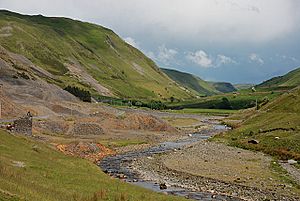Cwmystwyth Mines facts for kids
The Cwmystwyth mines are old mining sites found in Cwmystwyth, a village in Ceredigion, Wales. For a very long time, people dug here for valuable metals like silver, lead, and zinc. These mines are a big part of Welsh history.
Contents
Exploring Cwmystwyth's Mining Past
Cwmystwyth is a super important place for understanding mining history in Wales. It's like an open-air museum! You can see signs of mining from different times here. People started digging way back in the Bronze Age. Mining continued through the medieval period and then really picked up in the 1700s. It was busiest in the late 1800s before slowing down in the early 1900s.
This whole area is so important that it's protected as a Scheduled Ancient Monument. This means it's a special historical site. It also stands out in the beautiful Upland Ceredigion area.
A Look Back at Mining History
People have been mining silver, lead, and zinc in the River Ystwyth valley since Roman times. The mining really boomed in the 1700s. The biggest mine of all was the Cwmystwyth Mine itself.
Mining was very hard and dangerous work. Miners often faced health problems. For example, working with lead could make people very sick. Today, there is no more metal mining happening in the Ystwyth valley.
How Water Helped Miners
Water was super important for mining silver and lead. Miners used it to help get the valuable ore out of the ground. At Cwmystwyth mine, a lot of water came from miles away. It flowed through special channels called leats. These channels followed the shape of the hills. You can still see the path of these leats on the hillside today.
Miners used water for a technique called hushing. This involved releasing a lot of water quickly. It washed away soil and rock, helping them find new ore or work existing areas.
The Amazing Banc Ty'nddôl Sun-Disc
In October 2002, something incredible was found at the mining site. It was the Banc Ty'nddôl sun-disc! This disc is made of gold and is over 4,000 years old. That makes it the oldest gold object ever found in Wales. Imagine finding something so ancient!
Mining's Impact on Nature
Mining can sometimes affect the environment. In 1919, scientists checked the River Ystwyth. They found that only 9 types of creatures lived there, mostly insects. This was because of the mining activity. The river had a lot of lead in it.
By 1922, things were getting better. The number of species in the river grew to 26. The amount of lead in the water also went down. By 1939, there were 63 different species, but still no fish. The lead levels kept dropping. Finally, by 1975, fish had returned to most parts of the river. However, a 3-kilometer stretch below the Cwmystwyth mine still didn't have any fish. This shows how long it can take for nature to recover.
Gallery








